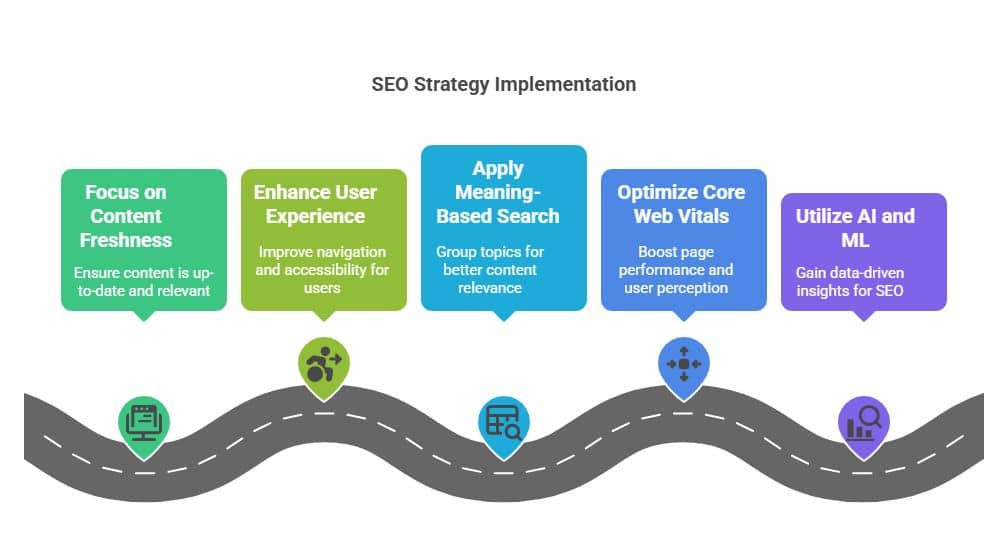
Mastering SEO: New Strategies Post-Algorithm Update
To master SEO post-algorithm update, focus on aligning with the latest trends and technologies. Adapt to recent algorithm changes by emphasizing content freshness, voice search, and local SEO. Ensuring an intuitive navigation system accessible features, and personalized content is crucial for delivering an excellent user experience. Improve the quality of your content by making it original and incorporating multimedia elements. Optimize Core Web Vitals for better performance, and embrace AI and machine learning for predictive insights. Enhance the network of inbound links & leverage structured data to boost online presence. Monitoring performance metrics ensures adjustments align with updates. Discover detailed strategies by continuing through the outlined steps.
Key Takeaways
- Focus on content freshness and relevance to align with evolving search engine priorities.
- Enhance user experience (UX) through intuitive navigation and accessibility improvements for better rankings.
- Apply meaning-based search and group topics for better content relevance & visibility.
- Optimize Core Web Vitals to boost user perception of page performance and search rankings.
- Utilize artificial intelligence and machine learning techniques to gain valuable data-driven insights.

Understanding Recent Algorithm Changes

Grasping the latest search engine algorithm updates is vital for keeping your website visible and boosting its online presence. As search engines continuously refine their algorithms, staying abreast of these changes is essential for effective keyword research and alignment with search intent.
The latest changes aim to give users better and more relevant results. They highlight the importance of fresh content & adapting to new tech like voice search and local SEO.
Keyword research has shifted from simple keyword density to a more sophisticated analysis of search intent. Understanding the underlying reasons why users search for specific terms is now paramount. This approach not only aids in crafting content that addresses user queries more effectively but also aligns with algorithmic preferences for relevancy.
Moreover, content freshness has become a critical factor. Search engines prioritize up-to-date information, rewarding websites that consistently update their content with improved rankings.
Voice search continues to rise in prominence, necessitating a reevaluation of traditional SEO strategies. As users increasingly rely on voice-activated devices, optimizing for natural language queries is imperative. It involves concentrating on everyday words & organizing information to respond to frequently asked verbal queries.
Furthermore, local SEO has gained increased importance as algorithms prioritize geographically relevant results. Businesses must ensure their online presence is optimized for local searches, enhancing visibility within specific regions.
This includes maintaining accurate information across online directories and fostering customer reviews to build local credibility. By understanding and adapting to these algorithm changes, businesses can sustain and enhance their online visibility in an ever-competitive digital landscape.
Prioritizing User Experience

User experience (UX) stands as a cornerstone of successful SEO strategies, fundamentally influencing how users interact with a website and, consequently, its search engine rankings. As search engines evolve, prioritizing UX becomes critical in shaping how content is presented and consumed. Implementing effective user engagement strategies ensures that visitors find the content valuable and engaging, which in turn, enhances dwell time and reduces bounce rates.
A key element of UX is intuitive navigation design, allowing users to seamlessly explore the site with minimal effort. Streamlining navigation not only aids in better user interaction but also signals to search engines that the website is user-friendly. Complementing this, accessibility improvements ensure that all users, regardless of disabilities, can access and benefit from the site’s content, thereby broadening reach and inclusivity.
| Strategy | Description | Impact on UX |
| User Engagement Strategies | Tactics to keep users actively involved | Increases time spent on site |
| Intuitive Navigation Design | Simplifies site exploration | Enhances usability and satisfaction |
| Accessibility Improvements | Ensures content is accessible to all | Expands audience and engagement |
| Content Personalization | Tailors content to individual preferences | Boosts relevance and user loyalty |
Content personalization techniques further refine UX by tailoring experiences to individual preferences, thus fostering a more personalized and engaging encounter. This approach not only increases user satisfaction but also builds long-term loyalty. Finally, integrating user feedback serves as a vital component in refining UX. By actively listening and responding to users’ needs, businesses can continuously improve and adapt their websites to better serve their audience, ultimately enhancing both UX and SEO performance.
Enhancing Content Quality

Elevating content quality remains a critical pillar of effective SEO strategies, as it directly influences both user engagement and search engine rankings. In the ever-evolving landscape of digital marketing, high-quality content goes beyond mere keyword stuffing. It requires a strategic approach that encompasses content originality and engaging storytelling to captivate and retain the audience’s attention.
- Content Originality: Creating unique and authentic content is essential for standing out in a saturated market. Original content not only enhances credibility but also fosters trust among readers and search engines alike. It should offer new insights or perspectives that add value to the audience.
- Engaging Storytelling: The art of storytelling can transform mundane information into a compelling narrative that resonates with readers. Effective storytelling involves weaving keywords seamlessly into the content, ensuring keyword relevance without compromising the flow of the narrative. This technique helps maintain reader interest and encourages longer site visits.
- Multimedia Integration: Incorporating multimedia elements such as images, videos, and infographics can significantly enhance the quality of content. Multimedia not only makes content more visually appealing but also aids in delivering complex information in an easily digestible format, thus improving user engagement.
- Audience Targeting: Understanding and addressing the needs and preferences of the target audience is crucial. Content should be tailored to the audience’s interests and search intent, ensuring that it is not only relevant but also actionable. This approach leads to higher user satisfaction and better search engine rankings.
Leveraging Semantic Search

Semantic search represents a paradigm shift in the way search engines interpret and deliver results, moving beyond mere keyword identification to understanding the intent and contextual meaning behind queries. This evolution requires marketers to adopt strategies that prioritize semantic keyword optimization and ensure search intent alignment. By focusing on the deeper layers of meaning, businesses can create content that resonates more effectively with user queries, thereby improving their search rankings.
A crucial component in leveraging semantic search is the use of topic clustering techniques. This involves structuring content around core themes and linking related subtopics, thereby creating a comprehensive network of information. Such clustering not only enhances content relevance analysis but also aids search engines in understanding the relational context of the material, improving its visibility in search results.
Natural language processing (NLP) plays a vital role in the semantic search landscape. By employing NLP, search engines can dissect and interpret the nuances of human language, providing more accurate results that align with user intentions. This technology enables search engines to consider synonyms, context, and user behavior patterns, thereby delivering results that are more in tune with user needs.
For marketers, aligning content with semantic search involves a deep understanding of the target audience’s search behaviors and intents. Through meticulous content relevance analysis, businesses can tailor their strategies to meet the evolving demands of modern search algorithms.
Optimizing Core Web Vitals

Focusing on optimizing Core Web Vitals is crucial for enhancing website performance and user experience, as these metrics are integral to Google’s page ranking criteria.
Core Vitals Importance lies in their ability to measure how users perceive the performance of a web page, specifically in aspects of loading, interactivity, and visual stability. These elements contribute significantly to the overall user experience, which in turn affects engagement and conversion rates.
To ensure your website is optimized effectively, consider the following strategies:
- Page Speed Optimization: A critical component of Core Web Vitals, optimizing your site’s speed can significantly impact user satisfaction. Techniques such as minimizing JavaScript, leveraging browser caching, and optimizing images can reduce load times and improve performance.
- Measuring Engagement: Utilizing tools like Google Analytics and Search Console can provide insights into user behavior and engagement metrics. Understanding these patterns helps in making data-driven decisions to enhance user interaction and content delivery.
- Enhancing User Interaction: Implement strategies to reduce First Input Delay (FID) by optimizing code execution and reducing the time to first interaction. This ensures that users experience minimal lag when interacting with your site, fostering a more engaging experience.
- Maintaining Visual Stability: Ensure that your pages maintain a stable layout during loading by addressing Cumulative Layout Shift (CLS) issues. This can be achieved by specifying size attributes for images and media, and avoiding content shifts that disrupt the viewing experience.
Focusing on Mobile-First Indexing

Mobile-first indexing represents a pivotal shift in how search engines evaluate and rank websites, emphasizing the importance of optimizing web experiences for mobile users. This change underscores the necessity of adopting mobile optimization techniques to ensure websites are not only accessible but also perform efficiently on various mobile devices.
Responsive design principles serve as a cornerstone for creating adaptable layouts that respond to different screen sizes, providing a seamless user experience. By implementing these principles, websites can maintain their aesthetic and functional integrity across both desktop and mobile platforms.
Additionally, Accelerated Mobile Pages (AMP) implementation strategies are crucial for enhancing page load speeds, which is a critical factor in mobile-first indexing. AMPs can significantly boost user engagement and reduce bounce rates, leading to improved rankings.
Understanding mobile user behavior is central to refining SEO strategies. Mobile users often exhibit different browsing patterns, preferring quick access to information and streamlined navigation. Websites should, therefore, focus on simplifying content and ensuring that crucial information is readily accessible. This approach not only aligns with mobile users’ expectations but also meets search engine criteria for relevance and usability.
Another aspect to consider is the voice search impact, which is increasingly shaping mobile search trends. Optimizing content for voice search involves using natural language and focusing on long-tail keywords that mirror spoken queries. This adaptation is essential as more users rely on voice-activated devices to conduct searches.
Incorporating these strategies into a cohesive mobile-first approach can help businesses remain competitive and responsive to the evolving landscape of digital search.
Embracing AI and Machine Learning
In today’s rapidly evolving digital landscape, integrating artificial intelligence (AI) and machine learning into SEO strategies is becoming increasingly essential. As search engine algorithms grow more sophisticated, leveraging AI applications can provide a competitive edge in optimizing online visibility and user engagement.
Machine learning, in particular, offers powerful tools for analyzing vast datasets to uncover actionable insights, thereby refining SEO efforts with precision.
One pivotal advantage of embracing AI in SEO is the ability to harness predictive analytics. These analytics can forecast search trends and user behavior, enabling businesses to anticipate market changes and adjust their strategies proactively. By understanding these patterns, organizations can tailor their content to meet emerging demands, ensuring relevance and boosting search engine rankings.
Moreover, content personalization is significantly enhanced through AI-driven strategies. By analyzing user preferences and behavior, AI can customize content delivery, ensuring that users receive information tailored to their interests and needs. This personalized approach not only increases engagement but also improves brand loyalty and conversion rates.
Automated optimization is another area where AI and machine learning shine. By continuously monitoring and adjusting various SEO elements, such as keyword usage and backlink quality, AI systems can maintain optimal performance with minimal human intervention. This not only saves time but also ensures that SEO strategies remain aligned with the latest algorithm updates.
Consider the following benefits of integrating AI and machine learning into your SEO strategy:
- Enhanced Predictive Analytics: Anticipate market trends and stay ahead of competitors.
- Improved Content Personalization: Deliver tailored experiences to boost user engagement.
- Efficient Automated Optimization: Maintain SEO performance with minimal manual effort.
- Data-Driven Insights: Utilize vast datasets for informed decision-making.
Strengthening Backlink Profiles

A robust backlink profile is a cornerstone of effective SEO strategies, significantly influencing a website’s authority and search engine ranking. With recent algorithm updates, the importance of quality over quantity in link building has been reinforced. High-quality backlinks from authoritative domains not only boost domain authority but also enhance credibility in the eyes of search engines.
To achieve this, businesses must adopt advanced outreach strategies, ensuring their content reaches the right influencers and websites that align with their niche.
Competitor analysis plays a critical role in strengthening backlink profiles. By examining the backlink strategies of top-ranking competitors, businesses can identify potential opportunities for acquiring high-value links. This involves understanding where competitors are sourcing their links and which domains contribute most to their authority.
Such insights can inform strategic outreach efforts and uncover untapped link-building prospects.
Anchor text is another pivotal element in developing a strong backlink profile. Careful selection of anchor text ensures that it is relevant and varied, avoiding over-optimization penalties from search engines. This balance helps convey the contextual relevance of the linked content, thereby enhancing its value and authority.
Implementing these methods requires a systematic approach to link building, characterized by genuine engagement and the cultivation of relationships with reputable websites.
This, combined with precise competitor analysis, creates a resilient backlink profile that withstands algorithmic changes. By focusing on quality backlinks, strategic anchor text, and effective outreach strategies, businesses can significantly improve their search rankings and maintain a competitive edge in the digital landscape.
Utilizing Structured Data
Structured data serves as a powerful tool in enhancing a website’s visibility and search engine performance. By providing search engines with explicit clues about the meaning of a webpage, structured data benefits include improved search result rankings and increased click-through rates.
Implementing schema markup is vital to harnessing these advantages, ensuring that search engines can better understand and represent content, thus optimizing rich snippets.
To effectively utilize structured data, consider the following key practices:
- Implementing Schema Markup: Begin by identifying the most relevant schema types for your content. Various schemas exist for articles, reviews, events, and more. Proper implementation ensures that search engines accurately interpret and display your content.
- Using Structured Data Tools: Leverage tools such as Google’s Structured Data Markup Helper and the Schema.org library. These resources simplify the process, offering guidance to correctly structure your data and validate its accuracy.
- Optimizing Rich Snippets: Rich snippets enhance a webpage’s listing by displaying additional information, such as ratings or images, making it more appealing to users. Focus on optimizing these elements to stand out in search results.
- Avoiding Common Structured Data Mistakes: Errors like incomplete markup, irrelevant schema types, or incorrect syntax can hinder performance. Regularly audit your structured data to avoid these pitfalls and maintain optimized content.
Monitoring SEO Performance Metrics

Effectively monitoring SEO performance metrics is crucial for understanding the success of your digital marketing efforts. By systematically analyzing these metrics, marketers can gauge the effectiveness of their strategies and make informed decisions to optimize their online presence.
Utilizing comprehensive SEO Toolkits is essential, as they provide a suite of tools designed to streamline the process of monitoring various performance indicators.
One of the primary aspects of SEO performance measurement is Rank Tracking. This involves keeping a close eye on where your website stands in search engine results for targeted keywords. Regular updates on rank positions help identify areas needing improvement and allow for timely adjustments in strategy.
Coupled with Rank Tracking, Traffic Analysis is indispensable, offering insights into the volume and sources of website visitors. Understanding traffic patterns aids in assessing the impact of SEO efforts on overall visibility and engagement.
Performance Benchmarks play a pivotal role in setting realistic goals and measuring progress over time. By comparing current performance metrics against industry standards or historical data, businesses can determine whether their SEO strategies are yielding expected results.
This benchmarking process ensures that objectives remain aligned with achievable outcomes.
Conversion Metrics are another critical component of performance monitoring. It’s not enough to drive traffic; the ultimate goal is to convert visitors into leads or customers. By examining conversion rates and user behavior, businesses can identify potential obstacles in the customer journey and enhance the efficacy of their conversion strategies.
Incorporating these elements into your SEO performance monitoring routine will empower your digital marketing initiatives with data-driven insights, ensuring sustained growth and adaptation to ever-evolving algorithm updates.
Final Thoughts
Adapting to the evolving landscape of SEO post-algorithm updates requires a multifaceted approach that emphasizes content quality, user experience, and technological integration. Prioritizing content freshness, voice search readiness, and local SEO strategies can enhance visibility, while ensuring accessibility and intuitive site navigation improves user engagement. Leveraging AI for predictive insights and optimizing Core Web Vitals are critical for maintaining performance and competitiveness. By focusing on meaningful connections through structured data and strategic link-building, businesses can build a robust online presence. Continuous performance monitoring allows for timely adjustments, keeping SEO strategies aligned with current trends and user expectations.
Ready to master the latest SEO strategies and boost your website’s performance? Connect with Syville Gacutan, an experienced SEO Specialist in the Philippines. Get personalized insights, expert strategies, and hands-on support to enhance your site’s search visibility and user engagement. Let’s take your SEO to the next level—reach out today!